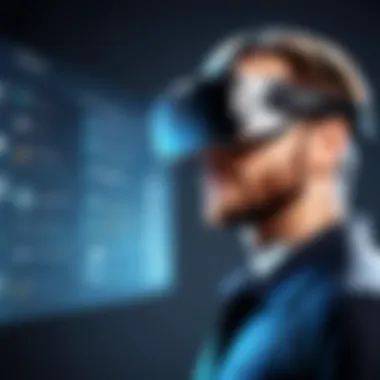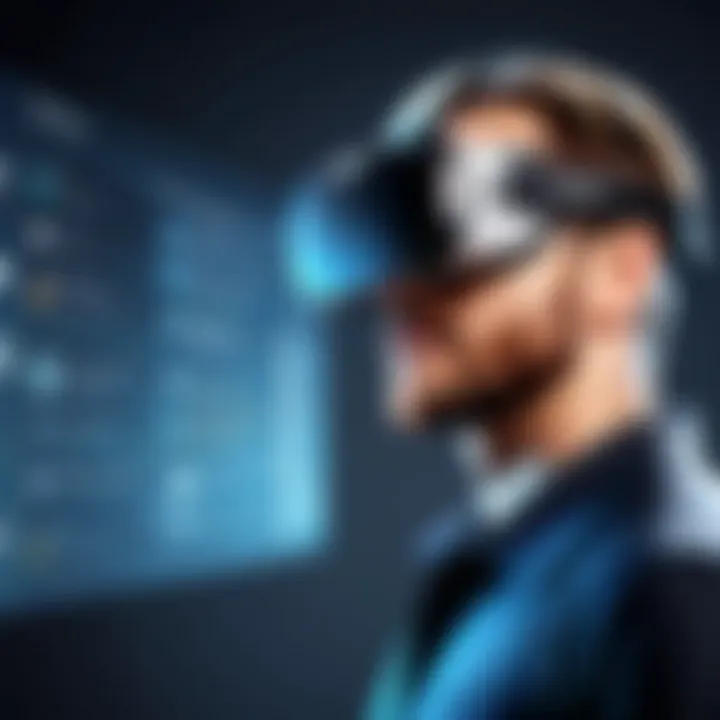Top Virtual Reality Software for Business and Leisure


Intro
The world of virtual reality (VR) is rapidly evolving, where innovation and creativity intersect to create immersive experiences. As businesses and consumers increasingly adopt VR solutions, understanding the landscape becomes essential. This article aims to guide you through the best virtual reality software available today, providing insights into their features, user experience, and applications across various industries.
Whether you are an entrepreneur looking for tools to enhance your business processes, an IT professional in search of the right software for projects, or a gaming enthusiast eager to explore new realms, comprehending the key aspects of these solutions is vital. This article endeavors to summarize essential characteristics while also conducting comparative analyses to empower your decision-making.
Software Category Overview
Definition and Importance
Virtual reality software encompasses a range of applications designed to create simulated environments. This includes gaming, training simulations, therapy tools, and educational platforms. The importance of VR software lies in its ability to provide users with unique, immersive experiences that traditional methods cannot replicate. It can enhance learning, foster creativity, and improve remote collaboration.
Key Characteristics
When examining VR software, several key characteristics stand out:
- User Experience: The ease of use and overall enjoyment that a user derives from the software.
- Hardware Compatibility: The ability of the software to function with various VR headsets and devices, such as Oculus Rift, HTC Vive, or PlayStation VR.
- Content Variety: The range of experiences offered, from gaming to training and experiential learning.
- Performance: The responsiveness and smoothness of the experience, critical for preventing motion sickness and ensuring user engagement.
Understanding these characteristics will help you gauge which software may align best with your needs.
Comparative Analysis of Top Software Options
Feature Comparison
Each VR software solution presents unique features. Some noteworthy options include:
- Oculus Home: Offers extensive customization and access to a library of VR experiences.
- SteamVR: A robust platform that hosts games, tools, and applications with extensive user support.
- Unity: This game development platform provides tools for creating both 2D and 3D experiences, focusing on customization and user engagement.
- Tilt Brush: A creative tool for painting in 3D space, enabling artistic expression in a virtual environment.
Pricing Models
When it comes to VR software, pricing can vary significantly based on the platform and features offered. Common models include:
- One-time Purchase: A single payment grants full access to the software, common in games and educational tools.
- Subscription-Based: Monthly or annual fees that provide continuous access to a range of services, often seen in enterprise-level solutions.
- Freemium Models: Basic access is free, but users can pay for additional features or premium content.
Understanding the pricing structures is crucial for making informed choices that align with your budget and usage needs.
Foreword to Virtual Reality Software
Virtual reality (VR) software represents a significant leap in how we engage with digital environments. In recent years, the relevance and application of VR have expanded across various sectors, prompting a need for a comprehensive overview of the best software available. Understanding virtual reality software is crucial for professionals in technology and business sectors. This article aims to delineate the categories, key players, and market dynamics influencing this evolving field.
The importance of VR software cannot be overstated. It allows users to experience immersion in fully simulated environments, which can enhance learning, increase engagement, and drive innovative solutions. Whether utilized in gaming, healthcare, or corporate training, the capabilities of VR are transforming how industries operate and interact with their audiences.
Definition and Importance of Virtual Reality
Virtual reality is defined as a computer-generated simulation of an environment that can be interacted with by a person using special electronic equipment. Typically, this includes headsets that incorporate head tracking and hand controllers that allow users to manipulate the virtual world.
The importance of virtual reality lies in its potential to create unique experiences that can lead to enhanced learning and retention. Here are some critical aspects:
- Immersive Environments: VR provides a sense of presence that traditional media cannot achieve. Users feel as if they are part of the environment, which is essential for effective training and education.
- Applications Across Industries: Various sectors, including education, healthcare, and business, are increasingly adopting VR to improve training methods, visualize complex data, and simulate real-life scenarios.
- User Engagement: In gaming and entertainment, VR has changed how content is created and consumed. Engaging users in interactive experiences fosters deeper connections and feedback.
"Virtual reality allows companies to exaggerate real-world conditions in a safe environment, boosting understanding and skill acquisition."
Overall, the rise of virtual reality software signals a new era of interaction between people and technology. With an array of applications and potential benefits, understanding its nuances is vital for decision-makers looking to integrate virtual reality into their strategies for growth and innovation.
Key Players in the Virtual Reality Software Market
In the realm of virtual reality software, identifying key players is critical for understanding market dynamics and the technological advancements being made. These companies influence not just the software’s development, but also its application across various industries. Knowing the prominent names in this space helps users and businesses to make informed choices and ensure they are leveraging the most advanced tools available.
Major Companies Developing VR Software
The landscape of VR software is populated by several influential companies that have been pivotal in its evolution. Here are some major players:
- Oculus VR: Acquired by Facebook, Oculus has developed notable headsets like the Oculus Rift and Quest. Their software environment emphasizes immersive gaming and social interactions, fostering a community of users and developers that push the boundaries of virtual experiences.
- HTC: With the HTC Vive, the company has carved a niche in both consumer and enterprise VR solutions. HTC has invested heavily in creating a robust ecosystem that supports VR content creation and distribution, appealing particularly to professionals in various sectors.
- Sony Interactive Entertainment: Their PlayStation VR software integrates seamlessly with their gaming console. This integration taps into the vast gaming market, offering unique gaming experiences while still catering to developers aiming to create innovative VR content.
- Microsoft: Their foray into VR through the Windows Mixed Reality platform highlights their commitment to blending virtual reality with productivity tools. Microsoft Mesh exemplifies their efforts to integrate VR with workplace collaboration, underscoring their dedication to enterprise applications.
- Unity Technologies: While not a VR software platform on its own, Unity is crucial in the development of VR applications. Many VR developers use Unity’s powerful engine to create immersive experiences, making it a foundation for many successful VR projects.
Understanding these companies gives insight into current trends and helps in anticipating future developments. As these key players innovate, they set standards that influence the entire industry, guiding other companies and developers.
"The success of virtual reality is heavily reliant on the creativity and technological prowess of its key players. Companies like Oculus, HTC, and Sony not only define experiences but also push the envelope on what is possible in VR."
As decision-makers analyze VR software options, recognizing the influence of these companies is essential. The strategic choices made by these players can significantly impact the available features, usability, and overall user experience in virtual reality.


Categories of Virtual Reality Software
Understanding the diverse categories of virtual reality software is crucial for anyone interested in making informed decisions in selecting the right solution. Each category serves specific needs and applications, providing unique features and user experiences. By recognizing the various types of VR software, users can identify which software aligns with their objectives, whether in entertainment, education, healthcare, or business. A well-considered choice facilitates better engagement and maximizes return on investment. This section will delve into the key categories, highlighting their importance and benefits.
Gaming and Entertainment VR Software
Virtual reality gaming and entertainment software have gained immense popularity over the past years. These platforms offer immersive experiences that transport users into different worlds. Titles like "Beat Saber" and "Half-Life: Alyx" exemplify this trend, combining physical movement with gameplay to create a new level of engagement. The technology allows for interactive storytelling and a deeper connection to the game world.
Key features of gaming VR software include:
- Immersive Environments – Users feel as if they are part of the game world.
- Physical Interaction – Many games use hand tracking and motion controls, adding to the realism.
- Social Features – Players can interact in shared virtual spaces, enhancing the multiplayer experience.
- Diverse Genres – From action to simulation, the variety appeals to different gaming preferences.
VR for Education and Training
The application of virtual reality in education and training is a significant advancement. VR enables immersive learning experiences that traditional methods cannot achieve. It simulates real-world scenarios, allowing learners to practice skills in a safe environment. Institutions and organizations are increasingly adopting VR for professional development and educational purposes.
Some benefits include:
- Enhanced Engagement – Students are often more engaged when learning through immersive experiences.
- Realistic Practice – Learners can hone skills in fields like medicine or engineering without the risks of hands-on training.
- Accessibility – VR can simulate environments and situations that may not be easily accessible in real life.
- Tailored Learning Paths – Programs can adapt to the learner’s pace, providing personalized experiences.
Healthcare Applications of VR
In healthcare, virtual reality software is proving valuable for both training and therapy. Medical professionals employ VR training simulations to practice surgeries or other procedures before performing them on patients. Additionally, VR is utilized in therapeutic settings, helping patients overcome fears or manage pain.
Advantages include:
- Safe Training Environments – Practitioners can learn skills without the potential for patient harm.
- Patient Treatment – VR can divert attention from pain during procedures or help manage anxiety disorders.
- Rehabilitation – Customized VR programs can assist recovery by making exercises engaging and enjoyable.
Corporate and Business VR Solutions
For businesses, virtual reality software is reshaping how teams collaborate and engage. VR solutions can be implemented for virtual meetings, training sessions, or product demonstrations, transcending geographical barriers.
Key elements of corporate VR include:
- Cost Efficiency – Reduces the need for travel expenses for meetings or conferences.
- Enhanced Collaboration – Teams can interact in shared virtual spaces, allowing for real-time brainstorming and project development.
- Training and Onboarding – New employees can experience interactive onboarding processes, making them feel integrated more quickly.
Art and Creative VR Software
Art and creative fields are actively exploring the capabilities of virtual reality software. Artists can use VR tools to create immersive installations or experiences that engage audiences in new ways. This technology allows for the manipulation of three-dimensional space with new artistic dimensions.
Benefits of creative VR software include:
- Innovative Expression – Artists can create interactive works that react to user input.
- Virtual Galleries – Artists can showcase their work in virtual spaces, reaching global audiences.
- Collaborative Projects – Creatives can collaborate in real time, irrespective of their physical location.
Each of these categories presents distinct opportunities and considerations. Understanding them can empower users to select optimized solutions suited for their specific requirements.
Factors Influencing the Selection of VR Software
In the rapidly evolving landscape of virtual reality, selecting the appropriate software is vital for both individual users and businesses. Understanding the factors that influence this selection ensures that one chooses software that aligns with specific needs and objectives. Key elements to consider include usability, compatibility, and financial implications. Each of these factors plays a distinctive role in determining the effectiveness and value of the VR software.
Usability and User Interface
Usability is a critical aspect in the selection of any software, and VR is no exception. The user's experience significantly depends on how intuitive and accessible the interface is. A software solution that is difficult to navigate may lead to frustration, negating the benefits of virtual reality. Users prefer software that provides a seamless and engaging experience.
Key considerations include:
- Ease of Learning: New users should quickly grasp how to operate the software without extensive training.
- Navigation: An intuitive layout encourages exploration and maximizes engagement.
- Customizability: The ability to adjust settings and preferences enhances user satisfaction.
A well-designed user interface fosters positive experiences, encouraging continued use and exploration of the software's full capabilities. Basic principles of design should be prioritized to accommodate various skill levels.
Compatibility with Hardware
Compatibility with existing hardware is crucial when selecting VR software. Not all VR software will function effectively on all systems. This can lead to wasted resources and dissatisfied users if the chosen software is incompatible with the user's setup.
Important factors include:
- System Requirements: Software should specify minimum hardware specs, such as CPU, GPU, and RAM.
- Device Support: Compatibility with various VR headsets and controllers must be considered.
- Performance: Some software may demand more resources, which can affect performance on lower-end systems.
Ensuring that VR software aligns with hardware capabilities enables a smoother experience. Users often want to maximize their investments in hardware, so selecting compatible software is essential for obtaining the desired effect without unnecessary upgrades.
Price and Licensing Models


Financial considerations are always a factor in software selection. The price of VR software varies significantly, as do the licensing models. Organizations and individual users must evaluate their budgets and needs to find suitable options.
Consideration factors include:
- Initial Cost: This includes one-time purchases or subscription models. Understanding the long-term costs is crucial for planning.
- Value for Money: Assess the features against the price to determine if it meets business or personal needs effectively.
- Licensing Terms: Different models, such as single-user, multi-user, or enterprise licenses, may significantly impact usability and access.
Choosing the right price point that aligns with required features helps avoid overextending budgets while meeting expectations. It's important to thoroughly assess the total cost of ownership and any additional costs that may arise later.
"Navigating the VR software market requires a keen understanding of usability, compatibility, and pricing strategies to ensure optimal selection for varied needs."
Top Virtual Reality Software Solutions
The category of Top Virtual Reality Software Solutions serves as a critical focal point in understanding the current landscape of virtual reality (VR) technologies. With advancements in both hardware and software, many solutions are emerging, each with its unique strengths and capabilities. Analyzing these options helps businesses and individuals make informed decisions that cater to their specific needs. Key factors in such a selection might include usability, compatibility, and the variety of applications served by the software.
Analysis of Oculus Software
Oculus, a product of Meta Platforms, offers some of the most recognized VR software solutions. The Oculus software suite is integral for users seeking immersive experiences. The platform provides various environments like games, social interactions, and productivity applications. The Oculus Store is robust, featuring a vast catalog of games, educational apps, and fitness experiences designed for both leisure and learning.
Key Features of Oculus Software:
- Seamless integration with Oculus hardware
- A rich ecosystem for gaming, including exclusive titles
- Social features to connect users in virtual spaces
The user experience is generally praised for its intuitive interface. However, some users may find the reliance on Meta accounts and online connectivity requirements limiting. Security and privacy are other considerations, given Meta's previous controversies.
Exploration of HTC Vive Software
HTC's Vive software offers another layer of functionality within virtual reality. It boasts a significant commitment to both gaming and professional environments. The Viveport platform features not only games but also applications for relaxation and exploration.
One standout feature of HTC's software is the Viveport Infinity subscription service. This model allows users to access hundreds of titles for a monthly fee, presenting a cost-effective solution for entertainment and experiences.
Pros of HTC Vive Software:
- Comprehensive support for various VR experiences
- Regular updates that enhance performance
- Strong community and developer support
However, challenges do exist, like hardware requirements and the high initial cost of the Vive devices. Users should evaluate these aspects against their budget and intended use.
Evaluation of PlayStation VR Software
PlayStation VR has made significant strides since its launch. As a console-based system, it provides users with unique advantages, particularly for those already in the PlayStation ecosystem. Its integration with PlayStation titles allows gamers to access a wide range of VR experiences.
Core Benefits of PlayStation VR Software:
- Accessibility through PlayStation 4 and PlayStation 5
- Extensive library of immersive games and experiences
- Easy setup that appeals to casual gamers
Nonetheless, the system does have limitations, primarily in both the scope of its library in comparison to rivals and the dependence on physical hardware for optimal performance. A strategic choice is essential when considering the long-term value of PlayStation VR software.
Features of Microsoft Mesh
Microsoft Mesh introduces a novel approach to virtual reality by focusing on collaboration and mixed reality platforms. Its software is designed for businesses to connect teams across remote locations seamlessly. Features designed for productivity give it an edge, from virtual meetings to interactive presentations.
Notable Attributes of Microsoft Mesh:
- Cross-platform functionality that integrates with a variety of devices
- Tools specifically crafted for professional and educational scenarios
- Enhanced collaboration capabilities that stand out in corporate settings
Microsoft Mesh exemplifies a shift towards utilizing VR beyond entertainment, emphasizing user engagement in practical environments. Given the context of remote work, its relevance continues to grow among professionals.
User Experience and Feedback
User experience (UX) and feedback are critical components to consider when evaluating virtual reality software. The interaction between user and software can define the overall effectiveness and enjoyment of a VR product. A positive user experience ensures better engagement and satisfaction, ultimately leading to productive outcomes, whether for gaming, training, or other applications.
The design of a user interface should facilitate ease of navigation. When users can easily access features without extensive training, they are more likely to favor that software. Moreover, a seamless user experience can enhance immersion, a key aspect of virtual reality. If users encounter frustration due to clunky design or difficulty in operation, their willingness to engage diminishes. Therefore, developers of VR software must prioritize intuitive interfaces and responsive interactions.
User feedback serves as a valuable resource that aids in the continuous improvement of VR software. Real-world reviews can shed light on various aspects like usability, features, and overall satisfaction. The insights gained from users who have actively engaged with the software can help identify strengths and weaknesses, influencing future updates and enhancements. This two-way communication between developers and users fosters an environment of adaptation and growth, crucial for keeping pace with evolving user expectations and technological advancements.
"User experience in VR is not just about functionality; it's about how users feel during their interaction with the software. Satisfaction often drives continued use and brand loyalty."
Importance of User Reviews
User reviews are indispensable in the realm of virtual reality software. Potential buyers often rely on collective experiences from others to determine the suitability of a product. This form of social proof can significantly influence decision-making, especially when potential users seek reliability and performance. Reviews can cover a vast range of topics such as installation ease, software stability, and the richness of content provided.


In VR, user reviews can highlight unique features that may not be apparent in marketing materials. They often reveal practical insights about how the software performs under real-world conditions, shedding light on elements like performance issues or enjoyable features that enhance usage.
Furthermore, companies can gather critical feedback from users. This feedback loop allows them to make necessary adjustments and keep customer needs at the forefront. Addressing common concerns and incorporating suggestions can lead to higher customer satisfaction levels, as clients feel their opinions are valued.
Case Studies of VR Software Usage
Examining real-world case studies can provide in-depth insights into how virtual reality software is being utilized across different industries. For example, consider the use of Oculus for training simulation in the healthcare sector. Medical professionals utilize Oculus' VR solutions for procedural training. These simulations offer a risk-free environment to practice complex situations, enhancing the skills of medical personnel without the high stakes involved in real-life scenarios.
Another relevant case could be HTC Vive in the field of architecture. Designers use this software to create immersive environments for clients. By visualizing designs in a virtual space, stakeholders can make more informed decisions about projects. This capability not only improves design accuracy but also enhances client engagement, allowing for better communication of ideas.
From a gaming perspective, PlayStation VR has enabled users to enjoy fully immersive experiences. The game experience transcends traditional formats by involving players in interactive narratives. Players report increased enjoyment and satisfaction as they engage more deeply with content, thanks to the immersive nature of VR gaming.
These case studies not only exemplify successful applications of VR software but also demonstrate how user engagement is elevated through thoughtful integration of technology in real-world scenarios.
Trends Shaping the Future of VR Software
Virtual reality continues to evolve rapidly. Understanding the trends shaping the VR software landscape is paramount, especially for decision-makers and professionals in technology and business sectors. These trends provide insight into possible future developments and can influence strategic decisions. Therefore, a clear grasp of what trends are emerging and how they may impact various industries is essential.
Emerging Technologies in VR
Technological advancements play a crucial role in the evolution of virtual reality software. Key areas to watch include:
- Artificial Intelligence (AI): The integration of AI enhances user interactions within VR environments. AI can create adaptive learning experiences in training simulations or improve NPC behavior in games.
- 5G Technology: The rollout of 5G networks offers greater speed and reliability for VR applications. This supports better streaming experiences and reduces latency, making VR more efficient and responsive.
- Mixed Reality (MR): The blending of virtual and augmented realities creates more sophisticated experiences. Software that allows objects to interact with both real and virtual elements opens many possibilities for education and entertainment.
- Haptic Feedback: Devices providing tactile sensations allow users to feel the virtual environment, enhancing immersion. This is crucial in applications like training or therapeutic scenarios.
These technologies not only improve user experiences but also expand the ways VR software can be utilized across various fields, including healthcare and education.
Increasing Industry Adoption
The acceptance of virtual reality in different sectors is rising steadily. Several factors contribute to this trend:
- Cost Reduction: As technologies mature, the costs associated with developing and deploying VR solutions decrease, making them accessible to more businesses.
- Broader Applications: Organizations across industries are discovering new ways to implement VR, from training simulations in corporate environments to immersive entertainment experiences that capture consumer interest.
- User Demand: There is a growing consumer desire for more engaging experiences, pushing businesses to invest in VR technology.
- Remote Collaboration: With the shift toward remote working, virtual reality offers solutions that help teams collaborate effectively without needing to be physically present.
The industry’s increasing reliance on VR paves the way for further innovations and enhancements, creating a feedback loop where advancements lead to even more widespread use of VR technology.
The trends in virtual reality software not only influence the technology itself but also restructure how businesses approach problem-solving and customer engagement.
Understanding these trends helps stakeholders navigate the landscape more strategically. Keeping an eye on future developments will prepare decision-makers to adopt VR solutions that align with their goals and the needs of their audiences.
Challenges in the Virtual Reality Software Landscape
The challenges in the virtual reality software landscape significantly influence both the development and adoption of VR technologies. Addressing these challenges is crucial for ensuring that VR can penetrate diverse markets more effectively. Potential problems not only impact user experience but also determine the future growth and acceptance of this innovative technology in various sectors.
Technical Limitations
Despite its promising capabilities, VR is not without its technical limitations. One major barrier is hardware dependency. High-quality VR experiences often necessitate powerful hardware, which can be cost prohibitive. Without the right equipment, users may face issues like poor performance and limited graphics quality. For example, solutions like Oculus Rift require a specific range of computing power to function optimally.
Additionally, latency issues can disrupt immersive experiences. A delayed response between a user’s actions and the visual output can lead to discomfort. This is particularly critical in fast-paced applications such as gaming where responsiveness is essential. Furthermore, the need for ongoing updates and maintenance can burden organizations that rely on VR solutions.
Another technical challenge is the interoperability among different VR platforms. Various software solutions may not work seamlessly together. As a result, developers often experience difficulties in creating applications that are compatible across multiple systems. This lack of standardization hinders user adoption since consumers are deterred by such barriers in switching between different systems.
User Accessibility Concerns
User accessibility remains a pressing concern within the VR space. Not all potential users can easily engage with VR software. Many applications require a specific level of awareness and comfort with technology. For example, elderly users or those with disabilities may struggle with complex interfaces, even if the technology could greatly benefit them.
The physical interaction required in VR experiences can also be a hurdle. Users with mobility impairments may find navigating 3D environments challenging. Moreover, creating inclusive content that addresses these accessibility issues remains a work in progress within the industry.
The End and Recommendations
The conclusion is a pivotal element of this article. It synthesizes the extensive discussion around virtual reality software, allowing professionals and enthusiasts to distill the critical information shared throughout. By summarizing key insights and providing actionable guidelines, this section aims to empower readers in making informed decisions regarding the selection of virtual reality software.
Moreover, it reinforces the relevance of understanding the nuances of various software solutions. As the virtual reality landscape rapidly evolves, being well-informed translates into competitive advantages for businesses and enhanced experiences for personal users. In light of these considerations, the conclusion serves as a bridge connecting the insights uncovered to practical application, thus ensuring that readers can leverage knowledge gained effectively.
Summary of Key Insights
In reviewing the best virtual reality software, several core insights emerge:
- Diversity of Applications: Virtual reality software spans various sectors including gaming, education, healthcare, and corporate environments. Each category addresses unique user needs.
- User Experience is Key: Exceptional user experience often dictates the success of VR software. Intuitive interfaces and immersive environments are essential.
- Compatibility Matters: The efficiency of VR solutions significantly depends on how well they function with existing hardware and platforms. Compatibility should be a major consideration.
- Technological Advancements: Emerging technologies, like artificial intelligence and real-time data processing, are setting new benchmarks for VR software capabilities.
- Industry Trends: Increased adoption across industries indicates a growing acknowledgment of the value VR brings, which creates further opportunities for development.
These insights provide a comprehensive view of the current state of virtual reality software and underscore the factors that stakeholders must consider in their software selection.
Guidelines for Choosing VR Software
Choosing the ideal virtual reality software can be daunting given the variety of options available. Here are some guidelines to simplify the process:
- Identify Your Purpose: Clearly define the primary objectives for using VR. Different software is built for distinct purposes, be it gaming, training, or collaboration.
- Assess Technical Requirements: Ensure that your hardware aligns with the software requirements. Not all VR software is compatible with every device.
- Evaluate User Experience: Look for software that offers intuitive navigation and engaging interactions. User feedback and reviews can provide valuable insights into usability.
- Consider Longevity: Opt for solutions that are likely to receive continued updates and support. Software that evolves is generally a better investment.
- Analyze Costs: Review pricing structures. Some software may offer subscription models while others might require a one-time purchase. Factor in potential licensing costs for businesses.
By following these guidelines, decision-makers can navigate the VR software landscape with greater confidence, aligning their choices with their specific needs and resources.







